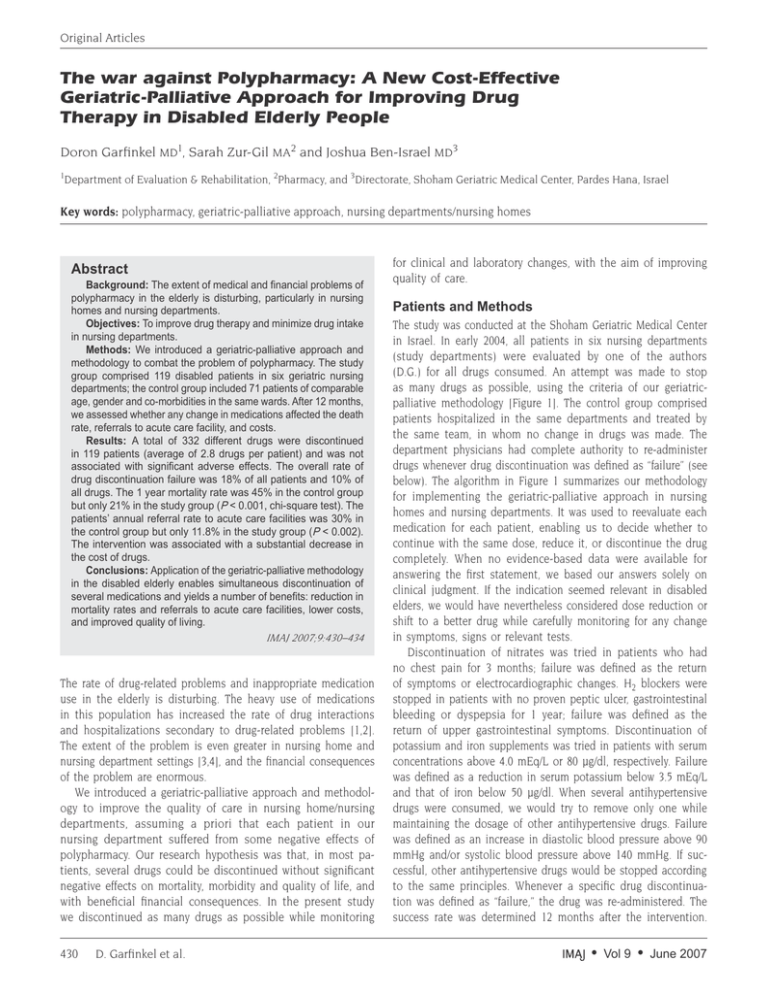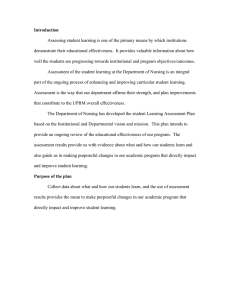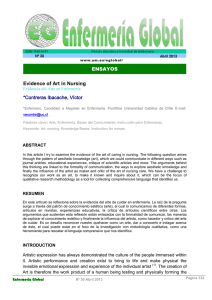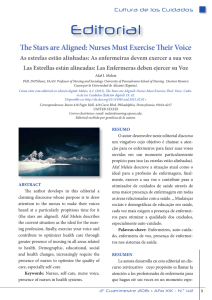The war against Polypharmacy: A New Cost
Anuncio

Original Articles The war against Polypharmacy: A New Cost-Effective Geriatric-Palliative Approach for Improving Drug Therapy in Disabled Elderly People Doron Garfinkel MD1, Sarah Zur-Gil MA2 and Joshua Ben-Israel MD3 1 Department of Evaluation & Rehabilitation, 2Pharmacy, and 3Directorate, Shoham Geriatric Medical Center, Pardes Hana, Israel Key words: polypharmacy, geriatric-palliative approach, nursing departments/nursing homes Abstract Background: The extent of medical and financial problems of polypharmacy in the elderly is disturbing, particularly in nursing homes and nursing departments. Objectives: To improve drug therapy and minimize drug intake in nursing departments. Methods: We introduced a geriatric-palliative approach and methodology to combat the problem of polypharmacy. The study group comprised 119 disabled patients in six geriatric nursing departments; the control group included 71 patients of comparable age, gender and co-morbidities in the same wards. After 12 months, we assessed whether any change in medications affected the death rate, referrals to acute care facility, and costs. Results: A total of 332 different drugs were discontinued in 119 patients (average of 2.8 drugs per patient) and was not associated with significant adverse effects. The overall rate of drug discontinuation failure was 18% of all patients and 10% of all drugs. The 1 year mortality rate was 45% in the control group but only 21% in the study group (P < 0.001, chi-square test). The patients’ annual referral rate to acute care facilities was 30% in the control group but only 11.8% in the study group (P < 0.002). The intervention was associated with a substantial decrease in the cost of drugs. Conclusions: Application of the geriatric-palliative methodology in the disabled elderly enables simultaneous discontinuation of several medications and yields a number of benefits: reduction in mortality rates and referrals to acute care facilities, lower costs, and improved quality of living. IMAJ 2007;9:430–434 The rate of drug-related problems and inappropriate medication use in the elderly is disturbing. The heavy use of medications in this population has increased the rate of drug interactions and hospitalizations secondary to drug-related problems [1,2]. The extent of the problem is even greater in nursing home and nursing department settings [3,4], and the financial consequences of the problem are enormous. We introduced a geriatric-palliative approach and methodology to improve the quality of care in nursing home/nursing departments, assuming a priori that each patient in our nursing department suffered from some negative effects of polypharmacy. Our research hypothesis was that, in most patients, several drugs could be discontinued without significant negative effects on mortality, morbidity and quality of life, and with beneficial financial consequences. In the present study we discontinued as many drugs as possible while monitoring 430 D. Garfinkel et al. for clinical and laboratory changes, with the aim of improving quality of care. Patients and Methods The study was conducted at the Shoham Geriatric Medical Center in Israel. In early 2004, all patients in six nursing departments (study departments) were evaluated by one of the authors (D.G.) for all drugs consumed. An attempt was made to stop as many drugs as possible, using the criteria of our geriatricpalliative methodology [Figure 1]. The control group comprised patients hospitalized in the same departments and treated by the same team, in whom no change in drugs was made. The department physicians had complete authority to re-administer drugs whenever drug discontinuation was defined as “failure” (see below). The algorithm in Figure 1 summarizes our methodology for implementing the geriatric-palliative approach in nursing homes and nursing departments. It was used to reevaluate each medication for each patient, enabling us to decide whether to continue with the same dose, reduce it, or discontinue the drug completely. When no evidence-based data were available for answering the first statement, we based our answers solely on clinical judgment. If the indication seemed relevant in disabled elders, we would have nevertheless considered dose reduction or shift to a better drug while carefully monitoring for any change in symptoms, signs or relevant tests. Discontinuation of nitrates was tried in patients who had no chest pain for 3 months; failure was defined as the return of symptoms or electrocardiographic changes. H2 blockers were stopped in patients with no proven peptic ulcer, gastrointestinal bleeding or dyspepsia for 1 year; failure was defined as the return of upper gastrointestinal symptoms. Discontinuation of potassium and iron supplements was tried in patients with serum concentrations above 4.0 mEq/L or 80 μg/dl, respectively. Failure was defined as a reduction in serum potassium below 3.5 mEq/L and that of iron below 50 μg/dl. When several antihypertensive drugs were consumed, we would try to remove only one while maintaining the dosage of other antihypertensive drugs. Failure was defined as an increase in diastolic blood pressure above 90 mmHg and/or systolic blood pressure above 140 mmHg. If successful, other antihypertensive drugs would be stopped according to the same principles. Whenever a specific drug discontinuation was defined as “failure,” the drug was re-administered. The success rate was determined 12 months after the intervention. • Vol 9 • June 2007 Original Articles Table 1. Demography and co-morbidities An evidence-based consensus exists for using the drug for the indication given in its current dosing rate, in this patient’s age group and disability level, and the benefit outweigh all possible known adverse effects S T O P No/Not sure Indication seems valid and relevant in this patient’s age group and disability level No Yes Do the known possible adverse reactions of the drug outweigh possible benefit in old, disabled patients? Yes Yes Any adverse symptoms or signs that may be related to the drug? No Another drug that may be superior to the one in question Yes A N O T H E R D R U G No Can the dosing rate be reduced with no significant risk? CONTINUE WITH THE SAME DOSING RATE S H I F T T O No No D R U G Yes Control group (n=71) Female/Male 87/32 44/27 Age (yrs) (mean ± SD) * 81.2 ± 8.3 82 ± 8.7 Dementia ** 112 )94%) 66 (93%) Double incontinence 111 (93%) 66 (92%) Indwelling urinary catheter 21 (18%) 10 (14%) Hypertension 55 (46%) 29 (41%) Congestive heart failure 12 (10%) 5 (7%) Previous myocardial infarction 6 (5%) 9 (13%) Chronic atrial fibrillation 16 (13%) 14 (20%) Diabetes mellitus 36 (30%) 17 (24%) Chronic obstructive lung disease 6 (5%) 9 (13%) Previous stroke 45 (38%) 28 (39%) Hypo-albuminemia (serum albumin < 3.0 g/dl) 29 (24%) 18 (25%) P NS NS * NS NS NS NS NS NS NS NS NS NS NS Recurrent infections *** 35 (29%) 13 (18%) NS All parameters except age, in both the study and control groups, were analyzed by the chi-square test. * Student’s t-test ** Mini Mental State Examination (MMSE) 14/30 or less. ***At least two proven infections in one year (urinary tract infection, pneumonia, skin infections etc.) Table 2. Success rate following 1 year of follow-up according to number of drugs discontinued REDUCE DOSE Figure 1. Improving drug therapy in disabled/frail elderly patients – an algorithm At that time, the annual incidence of deaths and referrals to hospitals was determined in both the study and control groups. All data were analyzed by the chi-square test. The average age was analyzed using Student’s t-test. Unfortunately, we could not reliably compare the cost of drugs for patients in whom drug discontinuation was and was not performed in the same six nursing departments. We therefore compared the cost of drugs in the six study departments (both study and control groups) to that of another four nursing departments in the same medical center (control departments), between January and July one year earlier, and the same period after the intervention (chi-square test). Results We evaluated the use of medications in 190 patients in the six study nursing departments. Drugs were discontinued in 119 (63%); there was no change of medications in 71. The groups were comparable for age, gender and major co-morbidities [Table 1]. The average number of medications consumed was 7.09. Altogether, 332 different drugs were discontinued (an average of 2.8 drugs per patient). The rate of successful drug discontinuation decreased as the number of discontinued drugs in one patient increased; the overall failure rate was 18% of all patients and 10% of all drugs [Table 2]. Table 3 presents the annual rate of success by different drug • Vol 9 • June 2007 Study group (n=119) Failure rate: re-administration No. of drugs discontinued No. of patients No. of patients No. of drugs 7 2 2/2 3/14 6 4 2/4 5/24 5 13 5/13 13/65 4 15 5/15 5/60 3 29 4/29 5/87 2 26 1/26 1/52 1 30 2/30 2/30 Total 119 21/119 33/332 Percent 100% 18% 10% types. The discontinuation of nitrates in 22 patients was not associated with any clinical or ECG changes; discontinuing H2 blockers did not cause upper gastrointestinal symptoms in 94% of patients; and discontinuation of antihypertensive drugs did not cause an increase in blood pressure in 42 of 51 patients (82%). Furthermore, in nine patients defined as “failures,” the number of antihypertensive medications or their dosage was reduced. The success rate for pentoxyfyllin, potassium and iron supplements was also remarkable. The failure rate of the geriatric-palliative approach was highest for antidepressants and psychotropic drugs [Table 3]. Other drugs were discontinued (e.g., non-steroidal anti-inflammatories, analgesics, statins, oral hypoglycemics, amantadine, carbamazepine and digoxin), with no adverse findings that could be attributed to drug discontinuation. Due to the Resolving Polypharmacy in the Disabled Elderly 431 Original Articles Table 3. Success rate after 1 year of follow-up according to types of drugs discontinued Drug group No. of patients with drug discontinuation Recurrence of symptoms/signs* (failures) Success rate (%) Nitrates 22 0 100% H2 blockers 35 2 94% Antihypertensives 51 9 82% Diuretics (furosemide) 27 (25) 4 (4) 85% Pentoxifylline 15 0 100% Potassium supplement 20 0 100% Iron supplement 19 1 95% Sedatives & tranquilizers 16 2 88% Antidepressants 19 5 74% Antipsychotics 13 4 69% * See text for further explanations small number of patients, statistical analysis was not performed for these drugs. In some patients in the study group, the staff reported decreased agitation, increased alertness and even an amelioration of disability, but we did not quantitatively assess these parameters. The 1 year mortality rate was 45% in the control group and 21% in the study group (P < 0.001). The annual referral rate to acute care facilities was also significantly lower in the study group as compared to the control group (11.8% vs. 30% respectively, P < 0.002). There was an overall decrease in the cost of drugs in all departments. This improvement was represented by a $0.26 decrease in the average daily cost of drugs per patient in 132 patients in the four control departments (from $1.65 before to $1.39 after the intervention period). This change did not reach statistical significance (P = 0.07). However, a statistically significant decrease of $0.46 in the average daily drug cost per patient (from $1.74 to $1.28, P = 0.02, chi-square test) was shown in 190 patients in the six study nursing departments following the intervention (119 patients in the study group + 71 patients in whom no change in drugs was made). Discussion There is an alarming increase in the number of people who suffer from disabling, non-curable diseases, which create exponentially increasing medical, economic and social age-related problems [5]. The more years a person lives, the more age-related diseases will be acquired and the more drugs consumed. Polypharmacy, an age-related “geriatric syndrome,” is a significant predictor of malnutrition, hospitalization and nursing home placement; it impairs mobility and leads to morbidity and death [6]. For professionals in palliative medicine and particularly those working in hospices, stopping drugs other than those used for symptom control is obviously a common practice. Nevertheless, polypharmacy represents a problem also in palliative care settings [7,8]. However, in geriatrics, there is less awareness and attempts to combat polypharmacy are much less aggressive. 432 D. Garfinkel et al. Residents in nursing homes or nursing departments use an average of 6 to 9.7 medications daily (7.09 in our study) and over 20% receive more than 10 medications daily [9,10]. The rate of drug-related problems in these settings is significantly higher than in community-dwelling elders [4,11,12]. Polypharmacy is preferably defined as “The administration of more medications than are clinically indicated” [13]. Another term is “inappropriate medication use” – medication use that has a greater potential risk for harm than benefit, is less effective or more costly than available alternatives, or does not agree with accepted medical standards. However, there is still considerable disagreement among experts regarding what exactly is inappropriate medication use and how it can be determined [14]. Beers et al. [10,15] tried to establish criteria for defining groups of drugs or specific medications that should be regarded as “potentially inappropriate” and should not be given to elders in nursing homes or nursing departments. Chutka and colleagues [16] claimed that there was insufficient evidence to conclusively defend or refute the use of most medications listed by Beers. This uncertainty may explain the different incidence of inappropriate medication use reported by many researchers in the community [1,3,14,17-19] and in nursing homes/nursing departments [4,20]. It also justifies the continuous attempts to reevaluate, modify and refine Beers’ criteria and expand them to include community-dwelling elders as well [3,17-19]. The updated Beers criteria may serve as an alarm system to increase physician alertness and avoid specific drugs in nursing homes/departments. We suggest that not only should we be aware of the high incidence of specific drug-related problems, but we should thoroughly reevaluate the indications for each drug. In this subpopulation, the sum total of the negative effects of a variety of drug combinations may outweigh the sum total of beneficial effects of the specific drugs. While comparing risks versus benefits of drug withdrawal in this subpopulation, one should remember that the rate of drug interactions is agerelated, the odds of inappropriate medication use are higher as the absolute number of medications prescribed increases, and the risk of hospitalization secondary to inappropriate medication use is much greater in these facilities than in the general population [1,2,11,21]. Furthermore, the validity of indications and benefits of specific medications in this subpopulation is not always evidence-based. Most guidelines for treating human maladies represent good evidence-based medicine in middle-age patients. However, they may be inappropriate, with greater risks and lower benefits, for institutionalized patients [22]. A well-accepted indication in adults may be unclear, no longer in existence, or irrelevant in the elderly, particularly in nursing facilities. For example, a patient who has received an antihypertensive or nitrates when still independent and active may not need these drugs years later when already disabled and exerting minimal physical effort. Patients may also have a life expectancy that is shorter than the time needed to benefit from any specific drug prescribed. A similar approach has been adopted for disabled elders with diabetes [23]. In the absence of proven data for determining • Vol 9 • June 2007 Original Articles optimal glycemic control in frail elders, a panel of experts made recommendations based on clinical judgment only. For the frail elderly, those with short life expectancy and others in whom the risks of intensive glycemic control outweigh the benefit, the panel did not adopt the general recommendations of the American Diabetes Association for lowering HbA1C to 7% and suggested a less stringent target of 8%. This approach should be expanded to include other clinical guidelines in an attempt to be less aggressive in reaching rigid target goals (for example, blood pressure, serum lipid concentrations), focusing rather on quality of life and patient/family preferences. In line with this perception, our approach aims at improving the quality of care in all 190 patients in the nursing department by reducing polypharmacy. We have proven our hypothesis that several widely used types of drugs are not necessarily needed in nursing home or nursing department patients [Table 3]. Primum non nocera, our second hypothesis, was that our intervention would not have deleterious outcomes. Our findings that both mortality and referrals to hospitals decreased significantly in the study group are intriguing. The explanation that these findings are bias-related seems unlikely. Based on clinical judgment only, physicians in the nursing departments decided whether to re-administer drugs or send patients to an acute care facility. For reasons of good medical practice, some patients in the study group were monitored more frequently than those in the control group (e.g., more blood pressure assessments, ECGs, laboratory tests). However, as this mainly occurred in the first weeks and the study was 12 months long, it does not explain the significant annual differences in favor of the study group. Avorn and co-workers [22] concluded that drug discontinuation should be done selectively, altering one drug at a time. However, in nursing department patients, who have the shortest life expectancy and the worst quality of life, time is critical and they may suffer further deterioration due to drug-related problems from the remaining medications. We therefore chose to withdraw several drugs simultaneously, while carefully monitoring for any clinical or laboratory adverse effects. Our study was not a randomized control trial. Nevertheless, it provides evidence for the efficacy of our geriatric-palliative approach. We recommend that randomized control trials be designed to conclusively assess our approach. However, performing such trials on multi-drug discontinuation in the complex nursing department/home subpopulation, while adhering to traditional rules of such trials, may be neither practical nor ethical. For example, it would require not only discontinuation of three to four specific drugs with no change in these same drugs in a comparable control group, but also continuation of the same drugs that are not withdrawn in both study and control groups. One may argue that we have not provided direct evidence for a higher rate of drug-specific problems in the control group (e.g., higher incidence of orthostatic hypotension or hypoglycemia in patients taking an antihypertensive or oral hypoglycemic, respectively). However, orthostatic hypotension is not relevant in disabled patients who cannot stand up. As for a possible beneficial decrease in hypoglycemic events, due to the small • Vol 9 • June 2007 number of patients in whom hypoglycemic medications were discontinued, statistical analysis was not relevant. Globally, physicians are increasingly exposed to patients suffering from a complexity of non-curable diseases. Nursing home/department patients may be treated by specialists who may work there part time while devoting the bulk of their time elsewhere, or by less costly non-specialists, who usually represent the preferred choice of the nursing home/department management. These patients may be taking medications that might have been given at some point in their lives by physicians of different specializations who prescribed the medication for a specific problem in their field of expertise. However, when policies were determined by specialists, the nursing department physician may be reluctant to discontinue drugs even when a long time has elapsed, new problems or medications accumulated, or physical changes occurred in the patient. Sometimes, neither specialists nor the nursing physicians review all drugs in a search for interactions with drugs prescribed by other doctors; therefore, a scheduled, formal drug reevaluation like ours may never be performed. We have chosen the term “geriatric-palliative” to describe our methodology for combating polypharmacy, because it is based on premises in both fields. All our patients suffer from non-curable diseases [Table 1] and our main goal is to relieve suffering using good palliative care medicine. The risk of polypharmacy may outweigh the combined benefits of all drugs, and drug discontinuation in itself should be regarded as one of our highest therapeutic priorities. At least in this subpopulation, the well-accepted geriatric guideline ”start low, go slow,” should be changed to “stop most, reduce dose.” In the USA, for every dollar spent on medications used in nursing homes, $1.33 is spent to manage drug-related problems [24]. Apart from the medical benefits, the financial benefits of our geriatric-palliative approach are considerable. Although it was performed in only 63% of patients in the study departments, the saving was still more pronounced than in the four control departments. Using this minimal estimate after correcting for the general saving represented by the control departments, the annual savings resulting from our approach would be $69 per patient. This estimate is much lower than that found by Trygstad et al. [12], who showed a relative annual cost reduction of $228 per patient. Suppose our approach or that of Trygstad et al. was implemented in at least 1.5 million nursing home patients in the USA and assuming the same cost of drugs, we would be looking at an annual saving of 103 to 343 million dollars in the U.S. alone, not including hospitalization savings. Although the average number of medications consumed by our patients was comparable to that reported by others, one may argue that the success of our approach stems from the fact that our patients were inadequately treated before the study. The situation may be better or worse in other countries or specific nursing homes/departments [25], but we believe that the extent of the problem is a global one. Therefore, using our approach to confront polypharmacy can help improve the health of patients and economies all over the world. In any case, the methodolResolving Polypharmacy in the Disabled Elderly 433 Original Articles ogy adopted can provide a useful checklist for even the best administration programs. References 1. Prescription Drugs and the Elderly: many still receive potentially harmful drugs despite recent improvements. Publication GAO/ HEHS-95-152. Washington, DC: United States General Accounting Office; 1995:1–30. 2. Lau DT, Kasper JD, Potter DE, et al. Hospitalization and death associated with potentially inappropriate medication prescriptions among elderly nursing home residents. Arch Intern Med 2005;165: 68–74. 3. Aparasu RR, Mort JR. Inappropriate prescribing for the elderly: Beers criteria-based review. Ann Pharmacother 2000;34:338–46. 4. Gurwitz JH, Field TS, Avorn J, et al. Incidence and preventability of adverse drug events in nursing homes. Am J Med 2000;109:87– 94. 5. Garfinkel D. Geriatric Boom Catastrophe – a major medical, economic and social nightmare of the 21st century. Proceedings of the 16th Congress of the International Association of Geron­ tology, 1997:364. 6. Frazier SC. Health outcomes and polypharmacy in elderly individuals: an integrated review. J Gerontol Nurs 2005;31:4–11. 7. Hanks G, Roberts CJC, Davies AN. Principles of drug use in palliative medicine. In: Doyle D, Hanks G, Cherny N, Calman K, eds. Oxford Textbook of Palliative Medicine, 3rd. edn. New York: Oxford University Press, 2004:214–25. 8. Twycross RG, Bergle S, John S, Lewis K. Monitoring drug use in palliative care. Palliat Med 1994;8:137–43. 9. Gurwitz JH, Soumerai SB, Avorn J. Improving medication prescribing and utilization in the nursing home. J Am Geriatr Soc 1990; 38:542–52. 10. Beers MH, Ouslander JG, Fingold SF, et al. Inappropriate medication prescribing in skilled-nursing facilities. Ann Intern Med 1992; 117:684–9. 11. Cooper JW. Adverse drug reaction-related hospitalizations of nursing facility patients: a 4-year study. South Med J 1999;92:485–90. 12. Trygstad TK, Christensen D, Garmise J, et al. Pharmacist response to alerts generated from Medicaid pharmacy claims in a longterm care setting: results from the North Carolina polypharmacy initiative. J Manag Care Pharm 2005;11:586–7. 13. Hanlon J, Schmader K, Rubi C, et al. Suboptimal prescribing in older inpatients and outpatients. J Am Geriatr Soc 2001;49:200–9. 14. Morton AH. Inappropriately defining “inappropriate medication for the elderly.” J Am Geriatr Soc 2004;52:1580. 15. Beers MH. Explicit criteria for determining potentially inappropriate medication use by the elderly: an update. Arch Intern Med 1997;157:1531–6. 16. Chutka DS, Takahashi PY, Hoel RW. Inappropriate medications for elderly patients. Mayo Clin Proc 2004;79:122–39. 17. Fick DM, Cooper JW, Wade WE, et al. Updating the Beers criteria for potentially inappropriate medication use in older adults. Arch Intern Med 2003;163:2716–24. 18. Goulding MR. Inappropriate medication prescribing for elderly ambulatory care patients. Arch Intern Med 2004;164:305–12. 19. Zhan C, Correa-de-Araujo R, Bierman AS, et al. Suboptimal prescribing in elderly outpatients: potentially harmful drug-drug and drug-disease combinations. J Am Geriatr Soc 2005;53:262–7. 20. Dhall J, Larrat EP, Lapane KL. Use of potentially inappropriate drugs in nursing homes. Pharmacotherapy 2002;22:88–96. 21. Zhan C, Sangl J, Bierman AS, et al. Potentially inappropriate medication use in the community dwelling elderly: findings from the 1996 Medical Expenditure Panel Survey. JAMA 2001;286:2823– 9. 22. Avorn J, Gurwitz JH. Drug use in the nursing home. Ann Intern Med 1995;123:195–204. 23. California Healthcare Foundation/American Geriatric Society Panel on Improving Care for Elders with Diabetes. Guidelines for improving the care of the older person with diabetes mellitus. J Am Geriatr Soc 2003;51:S265–80. 24. Bootman JL, Harrison DL, Cox E. The healthcare cost of drugrelated morbidity and mortality in nursing facilities. Arch Intern Med 1997;157:2089–96. 25. Fialova D, Topinkova E, Gambassi G, et al. Potentially inappropriate medication use among elderly home care patients in Europe. JAMA 2005;293:1348–58. Correspondence: Dr. D. Garfinkel, Head, Dept. of Evaluation & Rehabilitation and Palliative Unit, Shoham Geriatric Medical Center, Pardes Hana 37000, Israel. Phone: (972-4) 637-566; Telefax: (972-4) 637-5757 email: [email protected] Capsule Serological testing for celiac disease Hopper and co-workers tried to determine an effective diagnostic method of detecting all cases of celiac disease in patients referred for gastroscopy without performing routine duodenal biopsy. An initial retrospective cohort of patients attending for gastroscopy was analyzed to derive a clinical decision tool that could increase the detection of celiac disease without performing routine duodenal biopsy. The tool incorporated serology (measuring antibodies to tissue transglutaminase) and stratifying patients according to their referral symptoms. No cases of celiac disease were missed by the pre-endoscopy testing algorithm. The prevalence of celiac disease in patients attending for endoscopy was 3.9%. 434 D. Garfinkel et al. The prevalence in the high risk and low risk groups was 9.6% and 0.5%. The prevalence of celiac disease in patients who were negative for tissue transglutaminase antibody was 0.4% (7/2000). The sensitivity, specificity, positive predictive value and negative predictive value for a positive antibody result to diagnose celiac disease was 90.9%, 90.9%, 28.6% and 99.6%, respectively. Evaluation of the clinical decision tool gave a sensitivity, specificity, positive predictive value and negative predictive value of 100%, 60.8%, 9.3% and 100%, respectively. Br Med J 2007;334:729 Eitan Israeli • Vol 9 • June 2007




